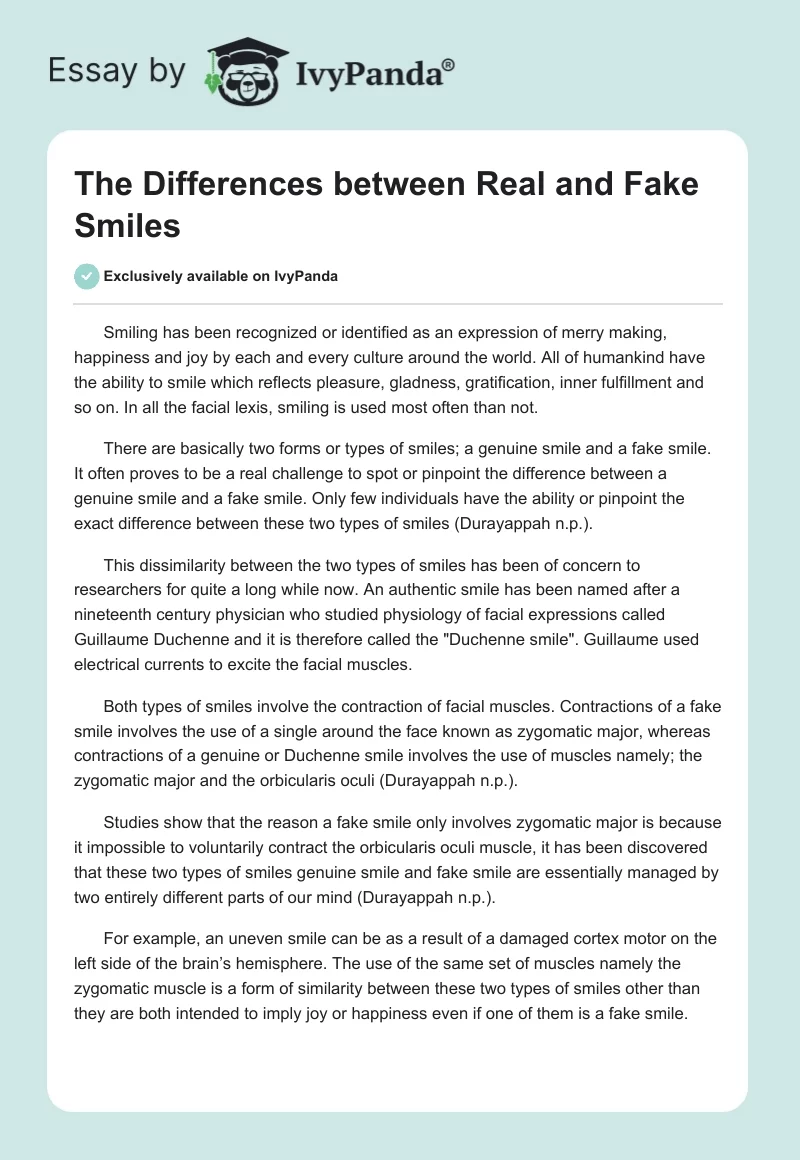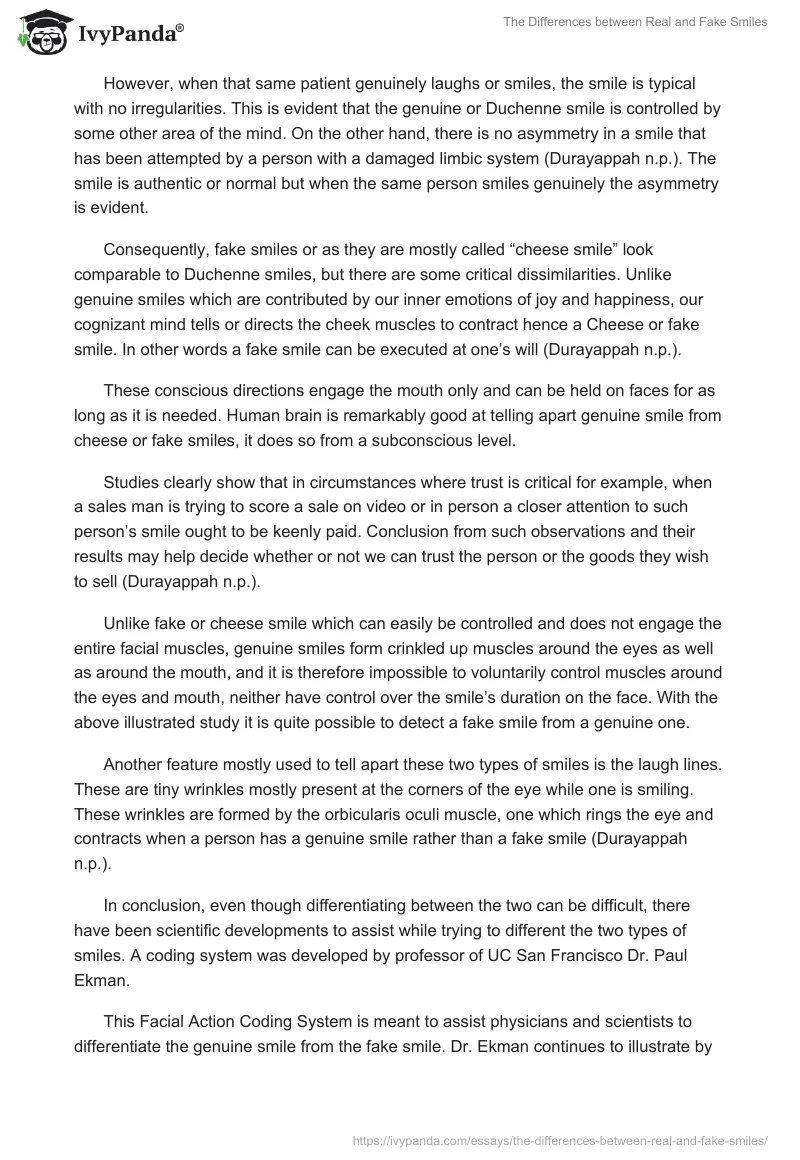Smiling has been recognized or identified as an expression of merry making, happiness and joy by each and every culture around the world. All of humankind have the ability to smile which reflects pleasure, gladness, gratification, inner fulfillment and so on. In all the facial lexis, smiling is used most often than not.
There are basically two forms or types of smiles; a genuine smile and a fake smile. It often proves to be a real challenge to spot or pinpoint the difference between a genuine smile and a fake smile. Only few individuals have the ability or pinpoint the exact difference between these two types of smiles (Durayappah n.p.).
This dissimilarity between the two types of smiles has been of concern to researchers for quite a long while now. An authentic smile has been named after a nineteenth century physician who studied physiology of facial expressions called Guillaume Duchenne and it is therefore called the “Duchenne smile”. Guillaume used electrical currents to excite the facial muscles.
Both types of smiles involve the contraction of facial muscles. Contractions of a fake smile involves the use of a single around the face known as zygomatic major, whereas contractions of a genuine or Duchenne smile involves the use of muscles namely; the zygomatic major and the orbicularis oculi (Durayappah n.p.).
Studies show that the reason a fake smile only involves zygomatic major is because it impossible to voluntarily contract the orbicularis oculi muscle, it has been discovered that these two types of smiles genuine smile and fake smile are essentially managed by two entirely different parts of our mind (Durayappah n.p.).
For example, an uneven smile can be as a result of a damaged cortex motor on the left side of the brain’s hemisphere. The use of the same set of muscles namely the zygomatic muscle is a form of similarity between these two types of smiles other than they are both intended to imply joy or happiness even if one of them is a fake smile.
However, when that same patient genuinely laughs or smiles, the smile is typical with no irregularities. This is evident that the genuine or Duchenne smile is controlled by some other area of the mind. On the other hand, there is no asymmetry in a smile that has been attempted by a person with a damaged limbic system (Durayappah n.p.). The smile is authentic or normal but when the same person smiles genuinely the asymmetry is evident.
Consequently, fake smiles or as they are mostly called “cheese smile” look comparable to Duchenne smiles, but there are some critical dissimilarities. Unlike genuine smiles which are contributed by our inner emotions of joy and happiness, our cognizant mind tells or directs the cheek muscles to contract hence a Cheese or fake smile. In other words a fake smile can be executed at one’s will (Durayappah n.p.).
These conscious directions engage the mouth only and can be held on faces for as long as it is needed. Human brain is remarkably good at telling apart genuine smile from cheese or fake smiles, it does so from a subconscious level.
Studies clearly show that in circumstances where trust is critical for example, when a sales man is trying to score a sale on video or in person a closer attention to such person’s smile ought to be keenly paid. Conclusion from such observations and their results may help decide whether or not we can trust the person or the goods they wish to sell (Durayappah n.p.).
Unlike fake or cheese smile which can easily be controlled and does not engage the entire facial muscles, genuine smiles form crinkled up muscles around the eyes as well as around the mouth, and it is therefore impossible to voluntarily control muscles around the eyes and mouth, neither have control over the smile’s duration on the face. With the above illustrated study it is quite possible to detect a fake smile from a genuine one.
Another feature mostly used to tell apart these two types of smiles is the laugh lines. These are tiny wrinkles mostly present at the corners of the eye while one is smiling. These wrinkles are formed by the orbicularis oculi muscle, one which rings the eye and contracts when a person has a genuine smile rather than a fake smile (Durayappah n.p.).
In conclusion, even though differentiating between the two can be difficult, there have been scientific developments to assist while trying to different the two types of smiles. A coding system was developed by professor of UC San Francisco Dr. Paul Ekman.
This Facial Action Coding System is meant to assist physicians and scientists to differentiate the genuine smile from the fake smile. Dr. Ekman continues to illustrate by saying that, one should be keen while trying to point out a type of smile. Dr.Ekna illustrates a state that might define both smiles and that might confuse an observer.
He says that corners of the lip being intensely pulled up by a large smile could pass for either genuine or fake smile. Dr. Ekna explains that the only part that will disclose the difference in a large concentrated smile is the skin amid the eyebrows and the upper eyelid. In a genuine smile the skin amid the eyebrows and the upper eyelid will definitely move slightly down as compared to a force smile where no such movement will be present.
Works Cited
Durayappah, Adoree. “What Science Has to Say About Genuine vs. Fake Smiles“. Psychology Today. 2010 Web.


